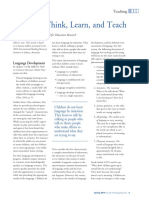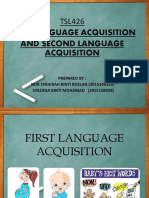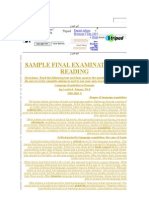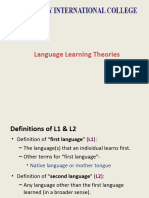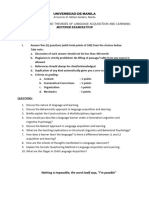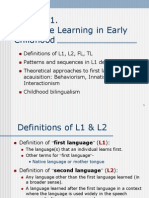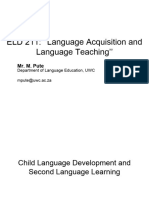Professional Documents
Culture Documents
3 Module Theories of Language and Language Acquisition
3 Module Theories of Language and Language Acquisition
Uploaded by
Genniel BasilioOriginal Description:
Original Title
Copyright
Available Formats
Share this document
Did you find this document useful?
Is this content inappropriate?
Report this DocumentCopyright:
Available Formats
3 Module Theories of Language and Language Acquisition
3 Module Theories of Language and Language Acquisition
Uploaded by
Genniel BasilioCopyright:
Available Formats
THEORIES OF LANGUAGE AND LANGUAGE ACQUISITION 1
Differentiate the kind of language
you use when talking to adults
with that of what you utilize when
communicating with
Engage babies/infants/ children.
More on…. LANGUAGE ACQUISITION OF CHILDREN
► It is said that children are not taught language. Instead, they grasp
the rules from the language around them.
► During the first year of life, children develop the sounds of their
language.
► Deaf children exposed to sign language show the same stages of language
acquisition as do hearing children exposed to spoken languages.
► Children can possibly acquire more than one language at the same time. Bilingual
children may have the some process of stages with that of monolingual children except
that they develop two grammars and two lexicons (dictionary/ list of words)
simultaneously.
► When adults talk to children, they sometimes use ‘Baby talk’.
Examples: choo-choo for “train”
bow-wow for “dog”
Words with baby-talk forms fall into the certain categories like food and animals. Also,
the words are phonetically simpler than the adult forms.
Example: tummy for “stomach” (Fromkin,V.,Rodman, R., & Hyams, N.,2003)
Do Children Learn through Imitation?
Child: My teacher holded the baby rabbits and we patted them.
Adult: Did you say your teacher held the baby rabbits?
Child: Yes.
Adult: What did you say she did?
Child: She holded the baby rabbits and we patted them…
Prepared by : Vanderlee M. Batalier
THEORIES OF LANGUAGE AND LANGUAGE ACQUISITION 2
Don’t children just listen to what people around them say and imitate?
Imitation is involved in some way but children do not just simply imitate adult
speech. Even if they try to imitate the words or sentences they hear, they cannot
produce these completely.
Examples:
Adult Child
He’s going out. He go out.
That’s an old-time train. Old-time train.
Adam, say what I say: Where can I put Where can I put them?
them?
Do Children Learn through Reinforcement?
Child: Nobody don’t like me. Reinforcement – It is
Mother: No, say “Nobody likes me.” the action of
Child: Nobody don’t like me. strengthening
(dialogue repeated eight times) something.
Mother: Now, listen carefully, say “Nobody likes me.”
Child: On, nobody don’t likes me.
There is a proposal that children learn to produce correct (grammatical) sentences
because they are rewarded or praised when they say something right, and are
commented or corrected when they say something wrong.
Roger Brown and his colleagues at Harvard University studied parent-child interactions.
Their study proved that such forms of reinforcement (stated above) seldom happen.
Also, attempts to correct a child’s language result to failure. In such situations, children
do not know what they are doing wrong and they cannot make corrections even if these
are pointed out, as shown by the example below.
Child: Want other one spoon , Daddy.
Father: You mean, you want “the other spoon.”
Child: Yes, I want other one spoon, please, Daddy.
Father: Can you say, “the other spoon”?
Child: Other…one…spoon.
Father: Say…”other.”
Child: Other.
Father: Spoon.
Child: Spoon
Father: Other… spoon.
Child: Other… spoon. Now give me other one spoon?
Prepared by : Vanderlee M. Batalier
THEORIES OF LANGUAGE AND LANGUAGE ACQUISITION 3
This kind of conversation between parents and children seldom occur. In fact, mothers
and fathers are simply happy when their young children are talking and consider every
utterance a gem.
Do Children Learn through Structured Input?
Another theory says that children are able to learn a language because adults speak to
them in a special “simplified” language sometimes called motherese, child directed
speech (CDS) or baby talk.
When individual baby talks, he sometimes speaks more slowly and clearly, exaggerates
his intonation and produces generally grammatical sentences.
Other examples of motherese/ baby talk:
Do you want your juice now?
Mommy thinks you should sleep now.
Pat the dog gently!
We don’t want to hurt him, do we?
Even if infants prefer to listen to motherese than the language of normal adult,
controlled studies show that motherese does not significantly affect the child’s language
development. The exaggerated intonation and other properties of motherese can be
possibly useful in getting and holding the attention of a child, but these are not a driving
force behind language development (Fromkin,V.,Rodman, R., & Hyams, N.,2003).
A SIMPLE COMIC STRIP.
An instruction will be given prior to our next face-to-face class.
Evaluate
Engage
In 1-2 paragraphs, cite a situation
in your life that manifests the
message of the quote. Expand
your answer and present it orally.
Send a video of yourself.
Prepared by : Vanderlee M. Batalier
THEORIES OF LANGUAGE AND LANGUAGE ACQUISITION 4
VARIOUS TERMS USED FOR FIRST LANGUAGE AND SECOND
LANGUAGE
FIRST LANGUAGE SECOND LANGUAGE
L1 L2
Native Language Non-native Language
Mother Tongue Foreign Language
Primary Language Secondary Language
Stronger Language Weaker Language
Source Language Target Language
ACQUISITION and FOREIGN LANGUAGE LEARNING
ACQUISITION FOREIGN LANGUAGE LEARNING
• Ellis (1985) and Krashen (1981)
support the idea that acquisition is
the spontaneous internalization of
rules and formulas.
• It happens in the speech community • It involves conscious process of
where one’s first language or learning through formal school-like
second language is spoken. settings and requires time for
• Generally, it takes place when a processing.
language is acquired naturally, • It is considered a habit formation.
without much focus on form.
• Example: Speakers of other
languages learn English in the • Example: An individual learns
United States. English in China
*** By the time students have acquired enough knowledge on the phonological,
grammatical and lexical patterns of a language, they will develop the habit of using them
as they practice them in numerous activities (Zingzhang,2005).
Prepared by : Vanderlee M. Batalier
THEORIES OF LANGUAGE AND LANGUAGE ACQUISITION 5
COMPETENCE and PERFORMANCE
COMPETENCE PERFORMANCE
• It is one’s knowledge of the • It is the act of showing one’s
language system itself. knowledge or ability to do
something.
It is the knowledge that native
speakers have of their language. It is what an individual does when
he speaks or listens.
• It is the non-observable ability to • It is the observable and concrete
do something. manifestation or realization of
competence.
• It is an individual’s abstract • It is an individual’s use of linguistic
linguistic knowledge. knowledge.
Sources: Theories in Second Language Acquisition
Gleason, J.B.,& Ratner N.B. (2013). The development of language. The 8 th edition.USA.Pearson
Education, Inc.
Zingzhang, Y.(2005). An introduction to linguistics. Higher education press.
Prepared by : Vanderlee M. Batalier
THEORIES OF LANGUAGE AND LANGUAGE ACQUISITION 6
Popular ideas about language learning: facts and opinions
The Most Important Factor in Second Language Acquisition Success is Motivation
Everyone agrees that learners who want to learn tend to do better than those who
don’t. But we must guard against too strong an interpretation of this. Sometimes,
even highly motivated learners encounter great difficulties in improving their
mastery of the language. We know, for example, that learners who begin learning
a second language as adults rarely achieve the fluency and accuracy that children
do in first language acquisition. This failure to achieve native-like ability cannot
be taken as evidence that adult second language learners are not motivated to learn
the language. We also know that in a group of highly motivated second language
learners, there are always those who are more successful than others. This is
sometimes due to differences in language learning aptitude and in how the
instruction interacts with individual learners’ styles and preferences for learning.
The Earlier a Second Language is Introduced in School Programs, the Greater the
Likelihood of Success in Learning
The decision about when to introduce second or foreign language instruction must
depend on the objectives of the language program in the particular social context
of the school. When the objective is native-like performance in the second
language, then it may be desirable to begin exposure to the language as early as
possible. The research evidence is fairly strong that only those who begin second
language learning at an early age will eventually be indistinguishable from native
speakers.
However, even in cases where such high levels of skill are targeted, it is important
to recognize certain disadvantages of an early start, especially when an early start
in second language means that children have little opportunity to continue to
develop their knowledge of their first language. Subtractive bilingualism may
have lasting negative consequences. For children from minority-language
backgrounds, programs promoting the development of the first language at home
an
Prepared by : Vanderlee M. Batalier
THEORIES OF LANGUAGE AND LANGUAGE ACQUISITION 7
and at school may be more important for long-term success in the second
language than an early start in the second language itself. Research shows that a
good foundation in the child’s first language, including the development of
literacy, is a sound base to build on. Children who can begin their schooling in a
language they already know will have more self-confidence, will be able to learn
more effectively in the early school years, and will not lose valuable time in a
period of limbo during which they struggle just to understand what is happening in
the classroom.
Most of the Mistakes which Second Language Learners Make are due to
Interference from their First Language
The transfer of patterns from the native language is undoubtedly one of the major
sources of errors in learner language. However, there are other causes for errors
too, one of which is overgeneralization of target-language rules. For example,
research has shown that second language learners from different first-language
backgrounds often make the same kinds of errors when learning a particular
second language. In such cases, second-language errors are evidence of the
learners’ efforts to discover the structure of the target language itself rather than
attempts to transfer patterns from their first language. Interestingly, some of these
errors are remarkably similar to the kinds of errors made by first language learners.
These observations are a strong indication that second language learning is not
simply a process of putting second-language words into first-language sentences.
Research has also shown that aspects of the second language which are different
from the first language will not necessarily be acquired later or with more
difficulty than those aspects which are similar.
On the other hand, when errors are caused by the overextension of some partial
similarity between the first and second languages, these errors may be difficult to
overcome. This may be particularly problematic if learners are frequently in
contact with other learners who make the same errors ( Lightbown &
Spada,1999).
Prepared by : Vanderlee M. Batalier
You might also like
- Changing The Language Ecology of KadazanDusunDocument9 pagesChanging The Language Ecology of KadazanDusunapi-3776865No ratings yet
- Tema 2. Teorías Generales Sobre El Aprendizaje Y La Adquisición de Una Lengua Extranjera. El Concepto de Interlengua. El Tratamiento Del ErrorDocument12 pagesTema 2. Teorías Generales Sobre El Aprendizaje Y La Adquisición de Una Lengua Extranjera. El Concepto de Interlengua. El Tratamiento Del ErrorJose S HerediaNo ratings yet
- UAS - MINI RESEARCH - Rohmatul JannahDocument17 pagesUAS - MINI RESEARCH - Rohmatul JannahRAHMANo ratings yet
- Practice 1Document2 pagesPractice 1Bob Brawyn0% (1)
- JRR 13-2 RabanDocument11 pagesJRR 13-2 RabanDL GirolettiNo ratings yet
- TEYL MaterialDocument111 pagesTEYL MaterialNi Luh Manik Santi Devi SitangsuNo ratings yet
- English For Young Learners (EYL)Document117 pagesEnglish For Young Learners (EYL)Cinta SalmaNo ratings yet
- Language Acquisition Myths & RealitiesDocument53 pagesLanguage Acquisition Myths & Realitiessherali ghulam hussainNo ratings yet
- First and Second Language AcquisitionDocument17 pagesFirst and Second Language AcquisitionJasper John RoqueNo ratings yet
- Week 3 LectureDocument23 pagesWeek 3 Lectureecekurt14No ratings yet
- 1 StandsndtheoriesDocument88 pages1 StandsndtheoriesMeli MacielNo ratings yet
- First Language Acquisition and Second Language AcquisitionDocument52 pagesFirst Language Acquisition and Second Language AcquisitionNoor KhanNo ratings yet
- Lecture 1 - Language AcquisitionDocument36 pagesLecture 1 - Language AcquisitionIra Amirul Razali100% (2)
- TheoriesDocument32 pagesTheoriesreiannefaithdinNo ratings yet
- Sample Final Examination in Reading: SearchDocument3 pagesSample Final Examination in Reading: SearchkhalidNo ratings yet
- Linguistic FinalDocument8 pagesLinguistic FinalToan PhamNo ratings yet
- Course PresentationDocument117 pagesCourse PresentationUyun's ChannelNo ratings yet
- SLA 4, L1 and L2 LearningDocument19 pagesSLA 4, L1 and L2 LearningNenden Sri FujiyaNo ratings yet
- FP003 CP CO Espv0r0.Docx Mishell UbeDocument7 pagesFP003 CP CO Espv0r0.Docx Mishell UbeJAZMIN UBE100% (2)
- La Adquisición de La L1Document5 pagesLa Adquisición de La L1Yazmin TitoNo ratings yet
- Haries Vi T. Micolob Lesson 1: Comprehension QuestionsDocument20 pagesHaries Vi T. Micolob Lesson 1: Comprehension QuestionsHaries Vi Traboc MicolobNo ratings yet
- Theories of Language LearningDocument24 pagesTheories of Language LearningBayissa BekeleNo ratings yet
- Formal Approaches To Sla-Universal Grammar Mat-English: Ivan T. BarrogaDocument39 pagesFormal Approaches To Sla-Universal Grammar Mat-English: Ivan T. BarrogaIVAN BARROGANo ratings yet
- Young Learners' Educational ModeDocument20 pagesYoung Learners' Educational ModeOkan EmanetNo ratings yet
- Module 1Document7 pagesModule 1Melissa Dela CruzNo ratings yet
- 1 Learning A First Language NewDocument42 pages1 Learning A First Language NewndhoatNo ratings yet
- Worksheet in Mother Tongue Week 1-4Document6 pagesWorksheet in Mother Tongue Week 1-4Karen Joy BaloloNo ratings yet
- 01-Assignment-withChecklist Renalyn B. LogueDocument5 pages01-Assignment-withChecklist Renalyn B. LogueRenalynNo ratings yet
- Popular Ideas About Language Learning RevisitedDocument28 pagesPopular Ideas About Language Learning RevisitedMarina Bustamante OrozcoNo ratings yet
- Profeeo1 - Module Chapter 5Document6 pagesProfeeo1 - Module Chapter 5scarletash169No ratings yet
- Unit4 - EDLS2611Document8 pagesUnit4 - EDLS2611Lenore ZamoreNo ratings yet
- Eng11-Sapon, Angelo Vincent R.Document4 pagesEng11-Sapon, Angelo Vincent R.Sapon, Angelo Vincent R.No ratings yet
- History of Language Development and Concepts Bilingualism: Lesson 1Document5 pagesHistory of Language Development and Concepts Bilingualism: Lesson 1Cayla Jen Basalan BunghanoyNo ratings yet
- Language Acquisition AssignmentDocument3 pagesLanguage Acquisition AssignmentMonikaNo ratings yet
- Natural Approach To Language Learning What It Is and How 7.8 Billion People Have Successfully Used It FluentU Language LearniDocument1 pageNatural Approach To Language Learning What It Is and How 7.8 Billion People Have Successfully Used It FluentU Language LearniJosue Jonatan AnayaNo ratings yet
- Language AcquisitionDocument17 pagesLanguage AcquisitionElif Guvendi Yalcin100% (2)
- ELT 1 Module 3Document4 pagesELT 1 Module 3Kristine CantileroNo ratings yet
- Contemporary Topics L1 U2 - Student BookDocument10 pagesContemporary Topics L1 U2 - Student BookOya HürNo ratings yet
- 4 Cognitive Development - LanguageDocument66 pages4 Cognitive Development - LanguageAarushiNo ratings yet
- Methods and Approaches To Second Language LearningDocument3 pagesMethods and Approaches To Second Language LearningAga SabeloNo ratings yet
- Seminar On LinguisticsDocument10 pagesSeminar On LinguisticssuriyachyNo ratings yet
- Lingustics II FINALDocument28 pagesLingustics II FINALLourdes LedesmaNo ratings yet
- 1 Learning A First Language NewDocument42 pages1 Learning A First Language NewlittlefbitchNo ratings yet
- Fundamentos IDocument4 pagesFundamentos IBelén EscuderoNo ratings yet
- Language DevelopmentDocument38 pagesLanguage DevelopmentStellaNo ratings yet
- Module-05.-Language-Development-and-Factors-Affecting-Cognitve-and-Language-Devt. (1) (Replica)Document6 pagesModule-05.-Language-Development-and-Factors-Affecting-Cognitve-and-Language-Devt. (1) (Replica)April kaye CabaticNo ratings yet
- An Introduction To Psycholinguistics Week 4: Teacher: Zeineb AyachiDocument20 pagesAn Introduction To Psycholinguistics Week 4: Teacher: Zeineb AyachiZeineb Ayachi100% (3)
- First and Second Acquisition: Suhendar Ayu Nuraeni Windi Ajeng CahyaniDocument25 pagesFirst and Second Acquisition: Suhendar Ayu Nuraeni Windi Ajeng CahyaniAyu NuraeniNo ratings yet
- ELD 211 - Lecture 2 - 20-02-2023Document14 pagesELD 211 - Lecture 2 - 20-02-2023bradeylinders110No ratings yet
- Second Language AcquisitionDocument30 pagesSecond Language AcquisitionДарина ДятченкоNo ratings yet
- Unit 1-Q Skills 5 RW-13-34Document22 pagesUnit 1-Q Skills 5 RW-13-34thanhbannhaNo ratings yet
- Rangkuman Model PembelajaranDocument8 pagesRangkuman Model PembelajaranUsman OppoNo ratings yet
- Lesson 2Document14 pagesLesson 2Disheila Mae TaparNo ratings yet
- L1 Language Theori 2023 V 2Document34 pagesL1 Language Theori 2023 V 2andreaNo ratings yet
- L2 AcquisitionDocument46 pagesL2 AcquisitionOmar H. AlmahdawiNo ratings yet
- Chapter 2 Purposive CommunicationDocument9 pagesChapter 2 Purposive Communicationjohn leeNo ratings yet
- Check Up Test Theories and Principles in Language Learning 1Document2 pagesCheck Up Test Theories and Principles in Language Learning 1Chinee MeleloaNo ratings yet
- ACQUISITIONDocument9 pagesACQUISITIONandreafresneda1999No ratings yet
- HallidayDocument26 pagesHallidaymariz cuizonNo ratings yet
- A2 Language Acquisition RevisionDocument53 pagesA2 Language Acquisition RevisioniancushingNo ratings yet
- Time to Talk: What You Need to Know About Your Child's Speech and Language DevelopmentFrom EverandTime to Talk: What You Need to Know About Your Child's Speech and Language DevelopmentRating: 5 out of 5 stars5/5 (3)
- ExplanationsDocument2 pagesExplanationsRica Mhay RosalesNo ratings yet
- MTB MleDocument22 pagesMTB MleYas SerNo ratings yet
- The Johns Hopkins University Press Transactions and Proceedings of The American Philological AssociationDocument12 pagesThe Johns Hopkins University Press Transactions and Proceedings of The American Philological AssociationlucasNo ratings yet
- Carpenter 1 SérieDocument2 pagesCarpenter 1 Sérieroselysobralgimenez2No ratings yet
- PassiveDocument2 pagesPassivebiljanaNo ratings yet
- PTE Listening TipsDocument3 pagesPTE Listening TipsRamesh Timilsina83% (6)
- Region X Division of MALAYBALAY CITY District Nine Bagong Silang Elementary SchoolDocument6 pagesRegion X Division of MALAYBALAY CITY District Nine Bagong Silang Elementary SchoolRecelgen LosariaNo ratings yet
- 7mo Clase 3Document2 pages7mo Clase 3Juan Carlos Quezada FernandezNo ratings yet
- TRABALHO DE CAMPO de Ingles Administracao Publica, 2022Document7 pagesTRABALHO DE CAMPO de Ingles Administracao Publica, 2022AlfredoNo ratings yet
- Whats The Root WordDocument2 pagesWhats The Root WordLucianny FilionNo ratings yet
- UAB Syllabus Upper Intermediate Spanish Language B2.1 3 CreditsDocument5 pagesUAB Syllabus Upper Intermediate Spanish Language B2.1 3 CreditsJakub Albert FerencNo ratings yet
- English Grade 3Document5 pagesEnglish Grade 3neematwalib4No ratings yet
- Definite and Indefinite TimeDocument5 pagesDefinite and Indefinite TimeJacqueline LeiteNo ratings yet
- SWF Dictionary 20180126Document342 pagesSWF Dictionary 20180126bendyFrog100% (1)
- Past Tense and Past Participle: ExerciseDocument12 pagesPast Tense and Past Participle: Exercisekalim949No ratings yet
- General EnglishDocument17 pagesGeneral EnglishalokpandeygenxNo ratings yet
- Murphy Et Al - English Grammar in Use, Reference and Practice For Intermediate Students-Páginas-35,37,39,41Document4 pagesMurphy Et Al - English Grammar in Use, Reference and Practice For Intermediate Students-Páginas-35,37,39,41Bog RodriguezNo ratings yet
- Password Reset C1C2 SB U1U2Document24 pagesPassword Reset C1C2 SB U1U2AleksNo ratings yet
- Verb Moods: Verb Moods Indicate A State of Being or RealityDocument13 pagesVerb Moods: Verb Moods Indicate A State of Being or RealityAnnabelle Gako100% (2)
- 88 Simple-Present-Be USDocument13 pages88 Simple-Present-Be USfredy96295No ratings yet
- G6 LP Week 2 (Q1)Document3 pagesG6 LP Week 2 (Q1)Ruthcie Mae D. LateNo ratings yet
- Unity and CoherenceDocument18 pagesUnity and CoherenceKha OulaNo ratings yet
- 2 MTB - TG SB Q1 W3Document13 pages2 MTB - TG SB Q1 W3RodrigoNo ratings yet
- The Effect of Using Authentic Materials in TeachingDocument6 pagesThe Effect of Using Authentic Materials in TeachingvioletavaleryNo ratings yet
- Til v. Till v. 'Til v. UntilDocument4 pagesTil v. Till v. 'Til v. UntilmiomirmNo ratings yet
- Full Aptis Practice Test 1 KeyDocument2 pagesFull Aptis Practice Test 1 KeySheryll Joan SolanoNo ratings yet
- Bing 12Document9 pagesBing 12Danang SatrioNo ratings yet
- SOAL SIMPLE PAST TENSE DAN PEMBAHASAN-dikonversiDocument2 pagesSOAL SIMPLE PAST TENSE DAN PEMBAHASAN-dikonversiArief Widha YuonoNo ratings yet





